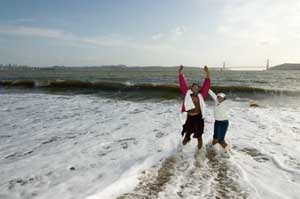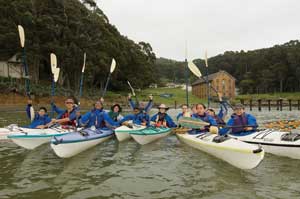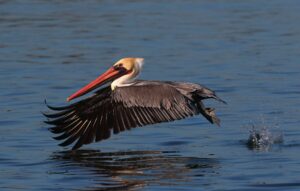As a sighted person, I take in most of my information about the world through my eyes. So I’m wondering how my fellow travelers perceive this journey when they can’t see the backdrop to our adventure: the impressive green of the hills, the quaint houseboats circling Richardson Bay, the gulls and terns wheeling above, and the Golden Gate Bridge in the distance. I close my eyes briefly to imagine what it might be like, and of course I find plenty to occupy the other senses as we make our way over the water to Angel Island: the cries of gulls floating into the foreground of perception; the sun on my back and the cold drips of water running off the paddle; the scents of salt and gasoline.
As our flotilla of eight kayaks approaches Raccoon Strait, I discover one disadvantage of my sightedness: My fellow paddlers can’t see the angry chop of the waves, row upon row of watery hands slapping at the kayaks, stirred by a current that threatens to tip us into the cold water. Crossing this passage is the most challenging part of getting from the relative calm of Richardson Bay to the island. The combined outflow of the Sacramento and San Joaquin rivers runs through here; over the millennia the force and volume of this torrent has carved a channel more than 100 feet deep. The combination of concentrated tidal currents and wind coming through the Golden Gate creates constantly changing surface conditions and large swells.
Reily White, our teenage ETC guide who’s had little to say beyond gentle kayaking pointers, now abandons diplomacy: “Paddle! Paddle!” he calls out. “Put your paddle in! It’ll help keep the boat from tipping!” We smack into the trough. For a second, my eyes close again, involuntarily; I’m literally blinded by fear. Then we plow through another swell and somehow come out, still upright, on the other side.
I glance at the other boats, floating now in calmer waters. The occupants, a group of visually impaired kids from the Oakland Unified School District in a program known as the Oakland VIPs (Visually Impaired Participants), are grinning. For them, conquering Raccoon Strait has been scary the way a carnival ride is, an exhilarating rush of adrenaline minus the apprehension I felt. I spot 17-year-old Haben Girma sitting quietly in one kayak, smiling to herself. Later, I ask how the experience was for her.
“It’s fun,” she responds, “pulling the boat along with my strength, pushing against strong water. It’s like pushing against an obstacle and overcoming it.”
That’s what Environmental Traveling Companions (ETC) does: helps folks of many different abilities overcome obstacles to outdoor experiences. For 34 years, the San Francisco-based nonprofit has been organizing adventures like this for people with special needs. People with low vision or mobility impairments do, after all, face a kind of wilderness everyday, navigating a world of sidewalks without curb cuts, Mount Everests of stairways, dangerous currents of downtown traffic. ETC’s trained volunteer guides transform the challenges of mountain rivers and choppy Bay waters into terrain that can likewise be conquered.
The kids number five: Denise Davis , 17, an ETC veteran who’s here as an assistant guide; Haben Girma, 17; Michael Keller, 16; Omar Arciniega, 14; and 14-year-old Erin Allen. They have varying levels of experience and ability, from Haben, an outdoor enthusiast, to Michael, who announces, “I hate wet water!” the minute he clambers into the kayak. They also have varying levels of sight, though they are all legally blind. Haben has a degenerative condition affecting her hearing as well as sight. Omar was only recently prescribed glasses to correct severe myopia. After a lifetime of legal blindness, he can see, and this has instilled a fearlessness that worries his teacher, Lisa Gessow, who’s along on the trip.
“He’s not supposed to run, or play any sports, because one fall or bump on the head could detach his retina and cut off his sight permanently,” she says with a sigh. “But of course he does anyway. There’s no stopping him since he got the glasses.” There’s really no stopping any of them as they shout and play their way through a weekend of paddling, hiking, and frolicking on Angel Island like any group of teens let loose in the spring sunshine.
- “The kids and teachers from the Oakland VIPs program and their ETCguides leave Camp Reynolds on Angel Island after their overnightadventure.”
The guides—Mark Dubois, Ron Cowell, and Fred Dennis—begged and borrowed equipment, inspired their friends to work for free, and managed to obtain some beat-up inflatable rafts that the navy yard on Treasure Island was getting rid of. “The whole thing was volunteer driven,” says Poslosky.
Low-income and visually impaired kids from Sacramento were the first to raft with this motley crew. Eventually the guides learned to incorporate people in wheelchairs, teens with cancer, kids with Down’s Syndrome, and so on. When these pioneer rafters lost their beloved river to the New Melones Dam after a long struggle in the mid-1980s, the young organization started looking for a way to bring the experience of the outdoors closer to an urban population. The result was the first accessible sea kayaking program in the country, based in the Bay Area’s “backyard wilderness,” San Francisco Bay. (The organization also now has a whitewater rafting program and accessible base camp on the South Fork of the American River and a cross-country skiing program at Bear Valley.)
“I love the sea kayaking because it’s an urban wilderness program,” says Greg Milano, Sea Kayak Program Manager and the leader of our trip. “We often work with low-income youth. Some of these kids have never been on a boat or even out of the city, but three hours after leaving home they’re having a wilderness experience within sight of the urban environment they’re from.”
That mission, and the looks on the kids’ faces the first time they find themselves afloat on the Bay or on the river, is what has drawn more than 400 trained volunteers to ETC. Several of them—Reily White, Kathy Hilimire, Edwin Dietrich, David Gibbons, and Suellen D’arblay—are with us today, calling instructions and encouragement to our little fleet.
“There are no hard and fast rules for working with people with disabilities,” Milano says. “It’s about being creative, open-minded, working with each individual as an individual. The most important adaptive equipment we have is our attitude and our volunteers. They enable us to have enough people to work with clients one-on-one. Being a guide is like being a shepherd. You guide the group, round up wandering boats, cheerlead, but ultimately the kids have to get themselves to the island.”
Denise has memorized the beach. It’s one way that visually impaired people get around, she explains. She lacks pupils, so her eyes are extremely sensitive to light; at times, when conditions are right, she can see perfectly, but mostly her world is flooded with uncomfortable glare. During past ETC trips and her time spent training as an assistant guide, she’s gained a familiarity with the small Sausalito beach where the kayaks are launched, filing in her mind the number of footsteps between the boat storage containers, the bathroom, the asphalt path, and the water’s edge.
As she helps carry paddles, life jackets, and other equipment to the beach, she’s a little worried about this trip. It’s her first time out as an assistant, and she’s a perfectionist. Will she get seasick? Will she make the distance without tiring? She feels everyone is depending on her and she’s nervous.
Not as nervous, however, as during her first ETC adventure, a skiing trip back in fourth grade. “I was so shy, but everyone was so open to converting their way to adjust to mine, so that helped me be more outgoing,” she says. “That was my first time in snow. I was excited, but it was so white it was blinding. At first it was terrifying, then so much fun. Skiing is like being in a dream world. I didn’t want it to end.”
Erin, the youngest of the group, whirls and dances over the sand, not at all apprehensive. She skitters to catch up as Milano calls us together in a circle. We play a game in which we reel off the names of each person in the circle, trying to memorize which moniker belongs to which person. The kids turn toward each of us, matching each voice with a name. Then Milano demonstrates paddling technique and talks safety. The kids bend to touch the boats, learning the form of stern and bow. The only time Erin stops moving is when she’s tucked into the kayak and pushed onto the water, accompanied in the boat by a sighted guide, like all the other students. Omar, too, is perpetually propelled by internal combustion. He doesn’t speak, but he grins, dipping his paddle in the water with determined rhythm toward the adventure of Raccoon Strait.
The kids are triumphant by the time the boats scrape the sand of Angel Island. We’re all a little tired, relieved, and wet, but the teens are revved up by what they’ve accomplished. Haben is particularly enchanted. “What vision I have I use a lot,” she says. “Coming across, I saw land, green trees, hills, water, sun.” This is an experience painted in broad strokes. We don’t, on this trip, get a glimpse of nature’s minutiae. What impresses these kids, with their limited vision, is a big-picture sensory perception of nature—its feel and fragrance, its expansiveness and color.
The guides have a couple of after-lunch games in store to warm us up. They all depend on listening, anticipating, and quick reactions rather than sight. When kayaks and gear are stashed safely on the beach, we form teams for rounds of snatch-the-lunch-pack (Haben is champion, hands down) and, after hiking up the hill, a game of Predator and Prey on the lawn in front of the old officers’ quarters. Eyes closed, kids and guides circle each other, trying not to burst out laughing as they fill the air with the incongruent vocalizations of dinosaurs, raptors, mountain lions, and goats.
Later, we hike to the concrete cannon mounts embedded in the west-facing slopes of the island, relics of World War II. Gessow holds her breath as Omar clambers catlike over the angled concrete walls and gun mounts, oblivious to the possibility that one small injury could end his seeing; the magic power of the new glasses has made him drunk with possibility. The kids love exploring the empty crypts of the abandoned bunker. When someone closes the heavy door as a prank, trapping us in obscurity, the kids giggle. None of them are afraid of the dark.
Next, a hike to Perles Beach makes us all a little high on the sheer splendor of the spring weather, the sunset, the chill lapping of wavelets at our ankles. Denise and Erin take off their shoes and run into the surf, pinwheeling arms and shrieking. “Sunset is the best,” Denise says. “I can see the mountains against the light.”
While the kids clean up after dinner, I speak with Gessow. Formerly a program manager for ETC, she now works as an “orientation mobility instructor” with visually impaired students for the Oakland school district. She teaches them to move around in the world: to navigate curbs and intersections, ride buses and BART.

- At Perles Beach, Denise and Erin run into the chilly surf toward the end of a beautiful spring day on Angel Island.
Gessow began signing her students up for ETC trips 15 years ago because she understood the impact these types of programs can have. “Being an inner-city kid is actually a bigger deal than vision in terms of limitations,” she says. “Low-income kids don’t see pictures of people like themselves kayaking, but now these kids all know the Bay and the Golden Gate Bridge at night. A lot of them had never seen snow, and now they all have. Our kids go back home having done something a lot of their friends haven’t done, and they know they can do more.”
She remembers Denise as a small, frightened child before her first ETC trip. “During the first night hike she was really scared.” But tonight, Denise can’t wait to experience the distant twinkling of San Francisco’s lights and the shape of the Golden Gate’s span traced in glowing bulbs. The girls hold hands as they start up the path toward the lookout, and Gessow’s amazed by the transformation.
“Denise has gone from being terrified to enrolling in ETC’s 24-day youth leadership program. Not all the kids turn into different people just by coming on the trips. Once we took a kid on a ski trip and all he did was roll around in the snow. That’s it. He was just doing the snow. And that was fine too.
“The social part is also important,” she adds. “Most visually impaired kids don’t know a lot of other kids like them, and it’s really important they’re around other kids with disabilities in settings where it’s no big deal. You wouldn’t think doing a kayak trip once a year could make such a difference, but it does.”
I anxiously watch the kids fixing breakfast the next morning. I’m waiting for Omar to chop off a finger as, nose to the task, he slices strawberries with a blade the size of a samurai’s sword. But these are kids who’ve hiked to the next mountain in life—from Omar, who did the shopping for this trip with Lisa’s help; to Mike, who started out complaining about his sisters but discovered he missed them more than he thought he would. Haben, whose family came to the U.S. from Eritrea when she was six, is already on her way: One of four valedictorians this year at Oakland’s Skyline High School, she’ll attend Lewis and Clark College in Portland on a full scholarship. She chose the school partly for its range of outdoor programs, including rock climbing.
“One of the most important parts of being around other blind kids is that I don’t feel different,” she says. “The first time I went to a blind summer camp, everyone was acting like it was cool to be blind. I wasn’t used to that.” ETC added another layer to her already adventurous spirit, she notes. “I hope that other people see me the way I feel—forthright, brash, confident.”
“People think we can’t do stuff because of our vision, but I found I can,” says Denise. “You have to say to yourself, ‘Can I adjust to this experience? Can I get in touch with myself and learn my boundaries?’ When people see me they know there are no boundaries.” She shoulders a paddle and grabs a pile of life jackets. Conjuring up her mental map, she turns into the sun and goes to stow the gear, the last chore for a young kayaking guide at the end of an adventure on San Francisco Bay.

.jpg)


-198x300.jpg)
.jpg)
-300x136.jpg)